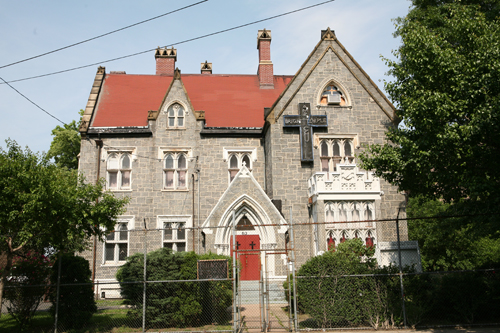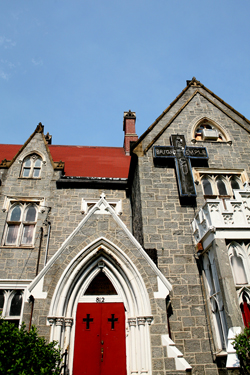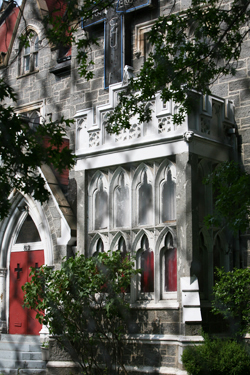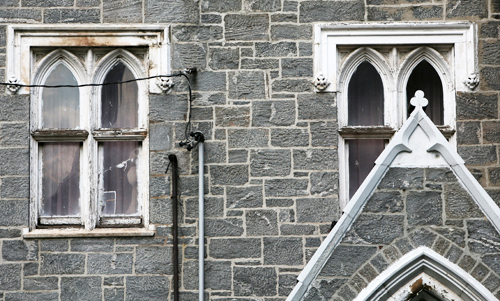Bright Temple
A.M.E. Church

Originally Peter A. Hoe House, Sunnyslope
812 Faile Street, at n.e. corner of Lafayette Avenue
architect, unknown
ca. 1859-1864
Now Bright Temple A.M.E. Church, this solid graystone Gothic Revival building survives from the mid-19th century on a small landscaped lot in the South Bronx. A handsome structure, it is a reminder of earlier mansions that once graced the estates of prominent New Yorkers attracted by the rural atmosphere of what was then Westchester County (later absorbed into New York City). Transit expansion, the break up of large area estates through land auctions, and the construction of dense apartment buildings, at the turn of the 20th century, changed the countrified area to the present urban and industrial Hunts Point neighborhood.
Stephen Smith Hoe (1821 – 1902), of the famous printing equipment family, built “Sunnyslope” in 1859 for his 14.5 acre estate; while his older brother Richard March Hoe (1812-1886) had a nearby estate “Brightside.” Often “Sunnyslope” and “Brightside” have been confused with each other in architectural and historical literature. The New York City Landmarks Preservation Commission’s designation of “Sunnyslope” as a landmark in 1981 dispelled this confusion through their close examination of local insurance atlases.
“Sunnyslope” is a 2-/2 story structure with large gables at the front and side. It has both gabled dormer windows and Gothic arched attic windows. Stone lintel details are over the lower windows, a three-sided oriel with trefoil panels and carved crenellation, and a Gothic arched entrance are a part of the face of the building. The building has a one-story addition on the southeast corner, a fire escape at the north elevation and a cross-shaped neon sign mounted on the front façade. None of these additions detract from the basic integrity of the structure. The architect of the original structure is unknown. Since American architecture as a field was in its infancy at the time of its construction, the structure may simply have been constructed by a builder who adapted his plan from published designs in Calvin Vaux’s then popular Villages and Cottages (1857).
In 1919, the building was used by Temple Beth Elohim, a German Reform synagogue that served the Jewish population in the neighborhood. Later the synagogue became a shul. During the Great Depression, upstairs classrooms were used for art lessons provided by a WPA teacher. The building is again serving a dual spiritual and scholastic mission. The church currently provides space for the girls program of the nearby St. Ignatius School, a private initiative in the small schools movement tradition. Johathan Kozol’s book Amazing Grace: The Lives of Children and the Conscience of a Nation (1995) touches on the spiritual life and worship of the congregation of this church.
Janet Butler Munch
Photographs:
Tom Stoelker



